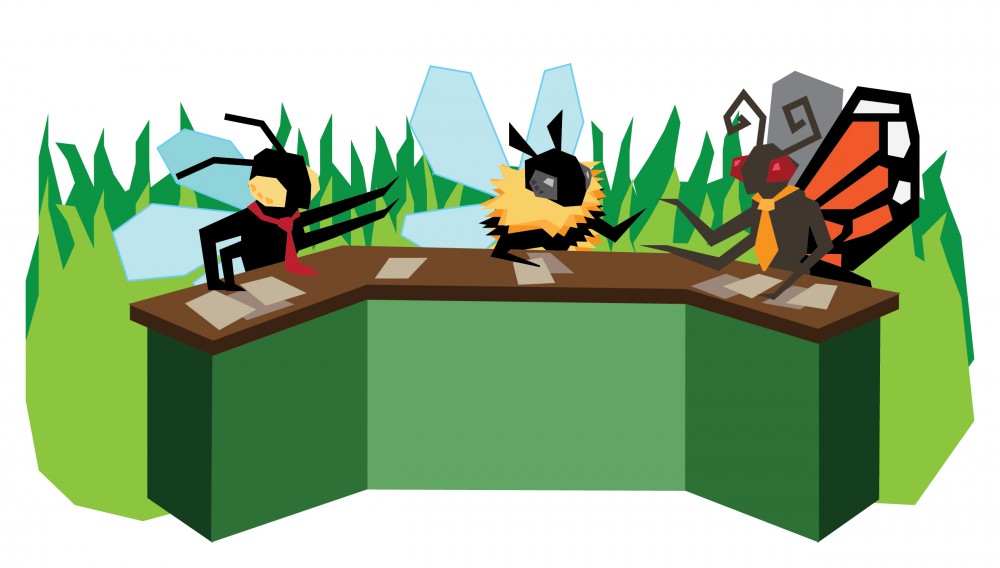A recently-published report provides recommendations for legislators on how to make Minnesota more friendly for pollinators.
A panel of 15 Minnesotans appointed by Gov. Mark Dayton, including two members from the University of Minnesota, released the report in late November.
Nearly two years in the making, the report gives a long list of recommendations proposed by members of the Governor’s Committee on Pollinator Protection. The suggestions fall under three categories: habitat, education and pesticide usage.
“Our hope is that our time together hashing through these issues and coming up with ideas that have floated to the top will lessen the workload for other decisions makers,” said committee member Sarah Foltz Jordan, who is also a pollinator conservation specialist. “I think our differences forced us to be realistic in terms of developing ideas that are likely to move forward through the legislators and encounter minimal opposition.”
Members of the committee come from various backgrounds. The committee includes professors, researchers, government officials, farmers and members of advocacy groups. One committee member is a representative from Syngenta, a leading pesticide manufacturer.
The recommendations reflected the diversity of perspectives. Some more moderate proposals received wide support, such as encouraging research spending and pushing for the expansion of pollinator habitats in rural, urban and suburban settings. Other suggestions were more divisive, including discontinuing neonicotinoid seed treatments in soybeans, a commonly used insecticide that harms pollinator populations.
“It was very difficult to come to consensus on some issues,” said Kevin Paap, a committee member and president of the Minnesota Farm Bureau. “Defining the issues depends on what side of the issue you’re on.”
Although only four of the issues reached full consensus, the collaborative efforts could not have come at a more critical time: pollinator populations have been in decline across the state for many years.
The monarch butterfly population is down by 90 percent over the past two decades. The Minnesota native rusty patched bumblebee was added to the endangered species list in 2017. The poweshiek skipperling, a pollinating butterfly once abundant in Minnesota, was last spotted in the state in 2008.
Marla Spivak, a professor in the Department of Entomology at the University and a committee chair, has studied honeybees for over 40 years. She said she’s seen a definite decline in honeybee populations and health.
“It sounds odd to talk about colony health, but they really have a number of stressors,” Spivak said. “A lot of that includes poor nutrition, lack of good floral habitat due to increasing acreages of corn and soybeans, landscaping practices, planting huge grass lawns that provide no floral food for bees.”
The issue of pollinator protection is complex and without a single solution. However, many committee members saw their diversity of backgrounds as a major leg up in developing realistic solutions, ones they hope, but are unsure if they will be, implemented under Governor-elect Tim Walz.
“I think our differences forced us to be realistic in terms of developing ideas that are likely to move forward through the legislators and encounter minimal opposition,” Jordan said.
This idea was seconded by committee member Dan MacSwain, the natural resource coordinator for Washington County. There are plenty of options for representatives and legislators to work with, he said – it will just take time.
“It took us a couple of years to get to this point, and I think it could be a couple more years for others to understand the complexity of issue and enact some of these recommendations to help address the issues at hand,” MacSwain said.
In the meantime, everyday citizens can take meaningful steps to preserve and protect pollinators.
Spivak said people can plant white clovers in their lawns, which can support over 40 species of bees. MacSwain recommends people plant flowers that bloom throughout the seasons.
Cutting back on insecticides in ornamental landscapes would be helpful, Jordan said, as they often provide little benefit in comparison to the harm inflicted on pollinators. She also said that continuing to have meaningful discussions can lead to meaningful impact, but it will take efforts on all fronts.
“How much do we need to do to make a difference?” Jordan said. “We need to do everything we can do.”

















